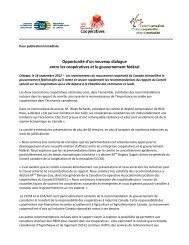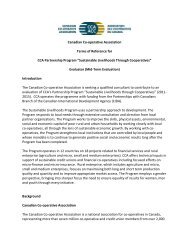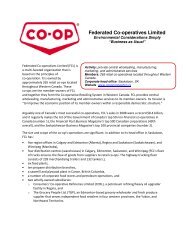Mountain Equipment Co-op - Canadian Co-operative Association
Mountain Equipment Co-op - Canadian Co-operative Association
Mountain Equipment Co-op - Canadian Co-operative Association
You also want an ePaper? Increase the reach of your titles
YUMPU automatically turns print PDFs into web optimized ePapers that Google loves.
Submission To The<br />
Special <strong>Co</strong>mmittee<br />
On <strong>Co</strong>-<strong>op</strong>eratives<br />
Presented by<br />
Shona McGlashan<br />
Chief Governance Officer<br />
Margie Parikh<br />
Vice-Chair, Board of Directors<br />
Head Office<br />
149 West 4th Avenue<br />
Vancouver, BC V5Y 4A6<br />
mec.ca<br />
MEC Submission To The Special <strong>Co</strong>mmittee On <strong>Co</strong>-<strong>op</strong>eratives 1
Introduction<br />
<strong>Mountain</strong> <strong>Equipment</strong> <strong>Co</strong>-<strong>op</strong> (MEC) was founded as a retail<br />
co-<strong>op</strong>erative in British <strong>Co</strong>lumbia in 1971. It remains head-quartered<br />
in Vancouver, where it is incorporated under, and governed by, the<br />
British <strong>Co</strong>lumbia <strong>Co</strong><strong>op</strong>erative <strong>Association</strong> Act (1999).<br />
The business began with six founding members who were active<br />
in BC’s early outdoor scene, a tiny store in downtown Vancouver,<br />
and gear focused on climbing. Since then, MEC has grown to<br />
become a national retailer with more than 3.75 million members,<br />
fifteen stores in six provinces, www.mec.ca, a 190,000-squarefoot<br />
Distribution Centre in Surrey, BC, some 1,600 employees,<br />
and a product offering that continues to grow and evolve in step<br />
with active outdoor lifestyles in Canada.<br />
Providing members with clothing and gear for backcountry<br />
excursions to wilderness destinations shaped MEC’s early product<br />
offering. Demographic changes within Canada and the trend<br />
toward ‘front-country’ recreation (close to home for short time<br />
periods) has led to the evolution of what is now MEC’s extensive<br />
outdoor product offering. It includes products and services<br />
that support members’ pursuit and enjoyment of cycling, hiking,<br />
camping, climbing, running, snowsports and watersports, among<br />
other activities.<br />
Stores in Vancouver and Calgary and a relatively small<br />
membership mainly within Canada’s two western-most provinces<br />
largely defined MEC’s growth in its first 15 years in business.<br />
That changed in 1986, when the outdoor retailer <strong>op</strong>ened a store<br />
in Toronto. Now, Ontario has five MEC stores, Quebec has three<br />
stores, and over half of the co-<strong>op</strong>’s total membership resides east<br />
of the Manitoba-Ontario border.<br />
Widely recognized for its commitment to sustainability and<br />
sustainable business practices, MEC supports various outdoor<br />
recreation and environmental conservation initiatives through<br />
its community involvement grants program. MEC’s sustainability<br />
efforts also include formal programs in the areas of ethical<br />
sourcing, green buildings, and product sustainability.<br />
Quick Facts<br />
Sales<br />
• Lifetime membership is <strong>op</strong>en to anyone by buying a $5<br />
share in the enterprise.<br />
• Almost 90% of MEC’s <strong>Canadian</strong> members reside in one<br />
of four provinces: BC (16.5%), Alberta (24.2%), Ontario<br />
(32.8%), and Quebec (16.3%).<br />
• In 2011, MEC averaged more than 18,750 new members<br />
per month.<br />
• In all, more than 13,000 separate products are available<br />
for purchase at MEC.<br />
• Approximately 40% of sales stem from private label<br />
(MEC-brand) products.<br />
MEC’s gross sales in 2011 totalled $270.1 million, an increase of 3.4%<br />
(or $8.8 million) from 2010. Ten years previously, in 2001, MEC’s<br />
sales totalled $153.9 million, or 43% less than where they now<br />
stand. The growth can largely be attributed to increased sales from<br />
investments in new stores (9 since 2001, including 3 in Quebec and<br />
3 in Ontario) and the growing p<strong>op</strong>ularity of mec.ca, MEC’s fastestgrowing<br />
sales channel.<br />
Pricing<br />
Benchmark pricing has long been a hallmark of MEC’s retail offering.<br />
This ‘low everyday price’ strategy means that members enjoy<br />
access to products that are, on average, 7% below market price.<br />
The strategy is achieved in part through comparatively low margins<br />
and low surplus earnings. For example, from 2009 to 2011, MEC’s<br />
margin averaged 33.4% of sales, while over the same period, MEC’s<br />
surplus earnings averaged 3.8% of sales.<br />
MEC Submission To The Special <strong>Co</strong>mmittee On <strong>Co</strong>-<strong>op</strong>eratives 2
Returns and Redemptions<br />
MEC has two types of shares: subscription shares and patronage<br />
shares. Individual shares of either kind are valued at $5. Members<br />
buy a single subscription share to join MEC. At the end of the<br />
year, after paying suppliers, employees, and <strong>op</strong>erating costs,<br />
MEC returns any surplus to its members, allocated in the form<br />
of patronage shares. This member capital is MEC’s main source<br />
of funding for future growth, given its limited access to other<br />
sources of funding due to its co-<strong>op</strong>erative structure.<br />
In the years when MEC’s financial affairs are sound and the<br />
organization is adequately funded, the co-<strong>op</strong> buys back<br />
a number of patronage shares from its members’ share<br />
accounts. MEC returns the money to members in the form<br />
of share redemptions.<br />
MEC has issued share redemptions to its members 12 times<br />
in its history, to total more than $18 million. The table below<br />
shows patronage returns and share redemptions from<br />
2001 to 2011.<br />
Year Patronage Return Share Redemption<br />
2001 $1,885,000 $1,200,000<br />
2002 $2,561,000 no redemption paid<br />
2003 $6,155,000 no redemption paid<br />
2004 $13,621,000 $1,020,000<br />
2005 $11,860,000 $2,062,000<br />
2006 $19,251,000 $2,086,000<br />
2007 $15,913,000 $3,565,000<br />
2008 $12,727,000 no redemption paid<br />
2009 $12,176,000 $342,000<br />
2010 $7,891,000 $2,228,000<br />
2011 $9,000,000 $2,481,000<br />
Employment<br />
MEC presently employs more than 1,600 pe<strong>op</strong>le. Not surprisingly,<br />
most – almost 80% – work directly in service to members in<br />
front-line retail jobs, in a mix of full-time, part-time, and casual<br />
employment positions. Operations, product devel<strong>op</strong>ment, and<br />
various other business requirements are supported by 278 Head<br />
Office employees in administrative, professional, and management<br />
positions. The balance of MEC’s staff handle in-bound freight and<br />
out-bound order and store fulfillment at the Distribution Centre.<br />
Guided overall by a strong member service ethic, jobs at MEC are<br />
as varied as retail is today complex. From financial, inventory and<br />
logistics analysts to IT experts, web devel<strong>op</strong>ers, product managers<br />
as well as HR, marketing, <strong>op</strong>erations and administration personnel,<br />
jobs at MEC encompass a broad spectrum. Moreover, the unique<br />
skill sets demanded by private-label (MEC-brand) product design,<br />
manufacturing, and sourcing give further dimension to MEC’s<br />
employment picture.<br />
In 2011, MEC’s payroll totaled more than $52.7 million, or 19.5%<br />
of total revenue for the year. By comparison, in 2001, compensation<br />
totaled roughly half as much ($25.5 million).<br />
MEC policy ensures that front-line retail employees’ compensation<br />
is above the labour market average for the retail sector. A regional<br />
pay scale is used to determine compensation. In more affordable<br />
cities, the pay scale is $11.50–$18.00 per hour; in more expensive<br />
cities (including Vancouver, Calgary, Toronto) the scale is $12.50–<br />
$19.00 per hour. As of January 1, 2012, the average wage for MEC<br />
store employees was $13.74 per hour.<br />
In 2010 and again in 2012, MEC was formally recognized as one<br />
of Canada’s T<strong>op</strong> 100 Employers. The recognition affirms MEC’s<br />
strategic goal of attracting and retaining t<strong>op</strong> talent by being<br />
a preferred employer.<br />
MEC Submission To The Special <strong>Co</strong>mmittee On <strong>Co</strong>-<strong>op</strong>eratives 3
<strong>Co</strong>mmunity Investment<br />
Through its <strong>Co</strong>mmunity Involvement Program, MEC invests<br />
in grants and partnerships to support organizations working<br />
on conservation and access to outdoor recreation, which together<br />
help support Canada’s outdoor community. In 2011, community<br />
contributions totaled $2.76 million. Of this, 64% was directed<br />
at projects or partnerships that support access to outdoor<br />
recreation or outdoor activities themselves. Since 2001, MEC<br />
has directed more than $16.6 million to community investments.<br />
Green Buildings<br />
MEC builds and <strong>op</strong>erates some of the most energy-efficient retail<br />
buildings in Canada. The Ottawa store was the first retail store<br />
in Canada to comply with the (now defunct) C2000 Green<br />
Building Certification, while MEC Montreal was the first store<br />
in Quebec to achieve the designation. Likewise, MEC’s Winnipeg,<br />
Burlington, Longueuil, Barrie, and North Vancouver stores have all<br />
been purpose-built to high green building standards, while other<br />
stores in the network have been retrofitted to accomplish similar<br />
objectives.<br />
MEC personnel have acquired in-depth knowledge and<br />
understanding of green buildings – and how green buildings<br />
can be tailored to support MEC’s brand and its sustainability<br />
objectives. In that light, MEC stores embody innovation, reducing<br />
the co-<strong>op</strong>’s ecological footprint while contributing community<br />
benefits, positive customer experiences, and healthy workplaces<br />
at the same time.<br />
Product Sustainability<br />
MEC is committed to advancing product sustainability efforts–<br />
inside and outside the organization. Internally, MEC employs<br />
a ‘lifecycle’ approach that is geared to choosing lower-impact<br />
materials and production techniques to build better products for<br />
members and reduce our ecological footprint. While work on this<br />
front has only been underway for a few years, it is yielding positive<br />
results: in 2011, 644 products were made with environmentally<br />
preferred materials (such as recycled polyester and organic cotton),<br />
while 39% of textiles came from facilities with environmental<br />
management systems. Formal targets have been set to increase<br />
both on an annual basis.<br />
Industry <strong>Co</strong>llaboration<br />
Notwithstanding efforts within MEC, a collaborative industry-wide<br />
effort is needed if product sustainability is to be fully realized.<br />
That’s why MEC has taken a leadership position in devel<strong>op</strong>ing<br />
and advancing the Eco-Index, a decision-making tool created<br />
by member companies of the Outdoor Industry <strong>Association</strong> that<br />
promises to transform product design and devel<strong>op</strong>ment. Technical<br />
assistance from the US Environmental Protection Agency has<br />
validated the effort and extended its reach into the wider apparel<br />
and footwear sectors.<br />
Proof of such reach is the Sustainable Apparel <strong>Co</strong>alition (SAC),<br />
of which MEC is a founding member. The SAC is a collaborative<br />
effort of retailers, brands, and other organizations that aim<br />
to reduce the environmental and social impacts of apparel and<br />
footwear products sold around the world. <strong>Co</strong>llectively, members<br />
of the SAC represent over one-third of global retail purchasing power.<br />
MEC Submission To The Special <strong>Co</strong>mmittee On <strong>Co</strong>-<strong>op</strong>eratives 4
Capitalization<br />
MEC makes investment decisions based on its financial outlook<br />
at a given point in time. Federal tax law enables MEC’s growth and<br />
its short- and long-term financial health by facilitating its ability<br />
to retain members’ capital to fund day-to-day working capital and<br />
store and product investments for members.<br />
The Canada Revenue Agency summarizes the applicable provisions<br />
(Section 135, Patronage Dividends) of the Income Tax Act as follows:<br />
“In computing income for a taxation year, a taxpayer is allowed<br />
to deduct patronage dividend payments made to customers.<br />
While the taxpayer involved is usually a co<strong>op</strong>erative corporation,<br />
sole pr<strong>op</strong>rietors, partnerships and ordinary corporations may also<br />
qualify for the deduction.” (Source: CRA Income tax Interpretation<br />
Bulletin IT-362R)<br />
In turn, this provision of the Income Tax Act corresponds to Section 5<br />
of MEC’s Rules of <strong>Co</strong>-<strong>op</strong>eration, Allocation of Surplus, which reads<br />
in part:<br />
5.02 Subject to Rule 5.01, the <strong>Co</strong>-<strong>op</strong>erative may apportion<br />
surpluses from its business to any or all of the following:<br />
a) declaring patronage returns, and distributing them<br />
to the members as set out in Rule 5.03,<br />
b) declaring dividends and paying them to the members<br />
at a rate not to exceed 8% yearly,<br />
c) retaining all or part of the residue for the purposes of the<br />
<strong>Co</strong>-<strong>op</strong>erative,<br />
d) donating all or part of the residue for charitable<br />
or educational purposes.<br />
Member Equity<br />
Members’ total equity in the co-<strong>op</strong> represents the slow and steady<br />
accumulation of subscription shares and patronage shares – minus<br />
redemptions paid – over the course of 40 years in business.<br />
Pooling members’ shares for mutual benefit helps MEC maintain<br />
solid financial health. In other words, members’ equity is retained<br />
in MEC to finance our <strong>op</strong>erations and improve our ability to serve<br />
members by investing in inventory, new stores, and infrastructure.<br />
The amount of patronage shares each individual member<br />
accumulates is small, but is significant when it is pooled with<br />
those of all other members. Indeed, at the end of 2011, members’<br />
combined equity in MEC totaled $160 million, an increase<br />
of $7.6 million from 2010.<br />
Recommendation<br />
Owing in part to its incorporation in BC, MEC has few direct<br />
dealings with the federal government. However, to the extent<br />
that MEC is both a retailer and a manufacturer, it is best aligned<br />
with the mandate and purview of Industry Canada. For this<br />
reason, MEC supports the <strong>Canadian</strong> <strong>Co</strong>-<strong>op</strong>erative <strong>Association</strong>’s<br />
recommendation to see Industry Canada as the federal ministry<br />
that would be responsible for the co-<strong>op</strong>erative sector.<br />
Beyond that, MEC encourages the Special <strong>Co</strong>mmittee<br />
to recognize co-<strong>op</strong>eratives as an important sector of the<br />
economy deserving of a policy and legislative framework that<br />
enables them to grow and thrive.<br />
Generally speaking, MEC has employed provisions a, b, and c above<br />
to build members’ equity through patronage returns, and<br />
to underwrite capital investments.<br />
It is important to emphasize that MEC’s capital structure is ‘lowgeared’<br />
– that is, total borrowings are low relative to total equity<br />
(see below). This conservative approach is a function of MEC’s lower<br />
surplus targets as well as MEC’s limited access to funding, which<br />
is generally confined to bank borrowing rather than alternatives<br />
available to other private or publicly traded companies.<br />
From 2001 to 2011, MEC’s capital investments (mainly store<br />
devel<strong>op</strong>ments and infrastructure) totalled $132.5 million.<br />
MEC Submission To The Special <strong>Co</strong>mmittee On <strong>Co</strong>-<strong>op</strong>eratives 5







